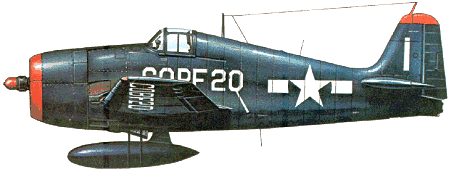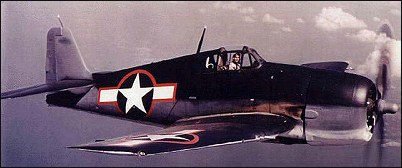|
| It is probably true to say that the Hellcat was designed in the spring of 1942, as important changes to the XF6F-1 and XF6F-2 prototypes led to the XF6F-3, which flew for the first time on 26 June 1942 (sometimes stated to be August). Large-scale production of the F6F-3 began at the end of that year and the Hellcat was first reported in action with a US Carrier Task Force in an attack on Marcus Island on 1 September 1943, flying from USS Yorktown.
The F6F-5 differed from its predecessor by having a redesigned engine cowling, improved windshield, new ailerons, strengthened tail surfaces, additional armour behind the pilot and a waxed high-gloss skin finish. It could also carry two 454kg bombs under the centre-section or drop-tanks, and was equipped to carry rocket projectiles and search radar as the F6F-5E. Night-fighter (F6F-5N) and photographic-reconnaissance (F6F-5P) versions were also in service.
The F6F-5K was a long-range radio-controlled pilotless drone conversion of the Hellcat. The modification was undertaken by the Naval Aircraft Modification Unit at Johnsville. Several were used in the Bikini operations.
The F6F-5 was the last operational version of the Hellcat, which was finally withdrawn from production in November 1945. The 10,000th Hellcat was delivered to the US Navy in March 1945 and final production amounted to 12,275. Interestingly the Hellcat was the only US aircraft designed and built after Pearl Harbor to be produced in this quantity and proved one of the most significant fighters flown in World War II, achieving a major victory against the Japanese in the Battle of the Philippine Sea. It was also flown by the Royal Navy as the Hellcat I and II.

| MODEL | F6F-5 |
| CREW | 1 |
| ENGINE | 1 x Pratt & Whitney R-2800-10W Double Wasp, 1491kW |
| WEIGHTS |
| Take-off weight | 6991 kg | 15413 lb |
| Empty weight | 4152 kg | 9154 lb |
| DIMENSIONS |
| Wingspan | 13.06 m | 43 ft 10 in |
| Length | 10.24 m | 34 ft 7 in |
| Height | 4.11 m | 14 ft 6 in |
| Wing area | 31.03 m2 | 334.00 sq ft |
| PERFORMANCE |
| Max. speed | 612 km/h | 380 mph |
| Cruise speed | 270 km/h | 168 mph |
| Ceiling | 11370 m | 37300 ft |
| Range w/max.fuel | 2462 km | 1530 miles |
| ARMAMENT | 6 x 12.7mm machine-guns, 2 x 454kg bombs or 6 x 127mm missiles |
 | A three-view drawing of F6F-5 Hellcat (1280 x 874) |
| CathyAnne, e-mail, 01.03.2010 09:09 My dad Ens. John W. Burton (eventually Lt. j.g.) was in the Night Fighting Unit VF-3. He flew with Lt. George L. Cassell, Ens. Lewis B. Humphrey, Ens. Clifford S. Tomlinson, and Ens. Carl E. Poston of the Fighting Three of Air Group Three from Oct 1, 1944 to March 1,1945 off the USS Yorktown. I have his Handbook and have been reading about their strikes over Canton, Hong Kong, Tokyo, Okinawa, Formosa, Iwo & Chichi Jima. He is 89 yrs old and still loves air planes. Recently he took his great grandson to EVERGREEN Aviation and Space Museum in McMinnville, OR just to see the historic fighter planes and the famed Spruce Goose. His stories from WWII are amazing. What a hero we have in our own family. We are so proud. reply | | Recordo, e-mail, 21.02.2010 17:42 Len: I remember in the early '50s seeing you and your pals flying F6fs out of Floyd Bennet in formation up and down the Rockaway peninsula. There was the occasional PBY but to my recollection, no F4Fs, F4Us or F8fs. What a shame that field was closed. My father was in a ferry squadron from 1942-45 tranporting aircraft between New York, Texas and California. reply | | J.W. Walsh, 18.02.2010 18:00 HI LEANN reply | | J.W walsh, 18.02.2010 17:59 Loved this airplane! Came back to the carrier more than once with multiple holes from either Zeke 7.7 mm. machine guns or Jap ack ack. Not good flotation characteristics though. Got shot down at Ishigaki and had to make a water landing. F6F went down in less than 60 seconds and left me swimming out of the cockpit. Rescued by a sub the next day though so all's well that ends well. Best Navy fighter of WWII. My dad was in the war my hole family is ! reply | |
| | Len Eisner, e-mail, 01.12.2009 23:58 I joined VF-3 out of operational training in mid 1945 and flew the F6 as George Cassell's wingman; he was the executive officer of the squadron. I truly enjoyed flying that airplane while in the squadron. I left the Navy in 46 to finish college and flew it extensively at Floyd Bennett field in the reserves, sometimes ferrying one to Alameda for overhaul and returning with a rebuilt one. After graduation and return to the service I flew it while waiting for new AM-1s to be delivered to the squadron I was in. Except for the F11F, I would pick the Hellcat as my all time favorite bird. reply | | Charlie Gray, e-mail, 02.11.2009 11:00 During my navy enlistment i was stationed at Point Mugu NAS from 1952-1954, assigned to operations [drones]at the main hangar and worked on the F6F-5K hellcats as a mech. We also had a few F8F bearcats as control aircraft but i much preferred working on the hellcats. What a great aircraft that was, and what a fine group of knowledgeable people i had the privilege of working with at that time. reply | | Mike Granat, e-mail, 19.07.2009 22:40 Flew the aircraft while with Fighting Squadron 3 (VF-3). With end of WW11, VF-3 formed a flight demonstration team (8 aircraft). Aside of normal flight ops, we performed shows to encourage pilot recruitment. Conducted last show at '46 National Air Races, Cleveland, Ohio. A three man team flying the new F8F Bearcat also performed. It was the inaugural act for a new flight demonstration team now known as the Blue Angels reply | | Laurence, e-mail, 29.05.2009 01:39 Even though the wildcat and hellcat look similar quite a few changes were made, 1 of note is the wing being taken from mid fuselage to low.Apparently a few japanese pilots made a similar mistake and paid the price for it especialy in its climb rate. reply | | randy, e-mail, 16.01.2009 23:38 I would like to know if it was radio gear that sat behind the pilot. if so, where can I find some photos? reply | | Ace, e-mail, 27.12.2008 08:26 this plane shot down over 1000 japanese aircraft.watch dogfights the zero killers for its action reply | | Luis, e-mail, 06.09.2008 23:15 It is exactly the same as the original F4F Wildcat with a better engine! Whats the point? They ould at least put in a new simpler design.... But above all a good and deadly plane... reply | | Fred J. Ferrazzano, e-mail, 26.05.2008 15:06 My very favorite propellor driven fighter aircraft of all time having worked for the Grumman "Iron Works" at Bethpage and flying in the fleet with carrier work in the mid 50's. reply | | Don Corzine, 05.05.2008 02:34 Loved this airplane! Came back to the carrier more than once with multiple holes from either Zeke 7.7 mm. machine guns or Jap ack ack. Not good flotation characteristics though. Got shot down at Ishigaki and had to make a water landing. F6F went down in less than 60 seconds and left me swimming out of the cockpit. Rescued by a sub the next day though so all's well that ends well. Best Navy fighter of WWII. reply |
|
Do you have any comments?
|
| 
COMPANY
PROFILE
All the World's Rotorcraft
|








